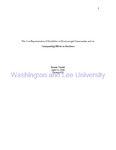| dc.rights.license | In Copyright | en_US |
| dc.creator | Vardell, E. Brooks | |
| dc.date.accessioned | 2013-12-02T16:45:23Z | |
| dc.date.available | 2013-12-02T16:45:23Z | |
| dc.date.created | 2010 | |
| dc.identifier | WLURG38_Vardell_POV_2010_wm | |
| dc.identifier.uri | http://hdl.handle.net/11021/24171 | |
| dc.description | Capstone; [FULL-TEXT FREELY AVAILABLE ONLINE] | en_US |
| dc.description | E. Brooks Vardell is a member of the Class of 2010 of Washington and Lee University. | en_US |
| dc.description.abstract | The State of Learning Disabilities, 2009 stated that -- "Families below the poverty line reported that 4.1% of their children (ages 6-17) have learning disabilities. For families that were not poor, that figure was 2.7%. The same is true for adults in poverty, who self-reported their learning disabilities at twice the rate of adults who didn't live in poverty (3.1% vs. 1.5% for adults ages 18-64 and 1.2% vs. .6% for those age 65 or older)" (8). This over representation of learning disabilities in disadvantaged communities creates difficulty distinguishing a causal relationship. Did poverty create the disability or did the disability lead to the poverty? Either way, the connection remains unavoidable. This relationship also poses some difficulties that lead to my interest in the topic. If children living in poverty have a higher probability of having a learning disability, how do they receive the resources they need to succeed? Impoverished communities have fewer resources, poorer schools, and less of a chance at diagnosing the disability let alone providing the necessary resources to promote an environment for a disabled individual to succeed to maximum potential. [From introductory section] | en_US |
| dc.description.statementofresponsibility | Brooks Vardell | |
| dc.format.extent | 31 pages | en_US |
| dc.language.iso | en_US | en_US |
| dc.rights | This material is made available for use in research, teaching, and private study, pursuant to U.S. Copyright law. The user assumes full responsibility for any use of the materials, including but not limited to, infringement of copyright and publication rights of reproduced materials. Any materials used should be fully credited with the source. | en_US |
| dc.rights.uri | http://rightsstatements.org/vocab/InC/1.0/ | en_US |
| dc.subject.other | Washington and Lee University, Shepherd Poverty Program | en_US |
| dc.title | The Over Representation of Disabilities in Disadvantaged Communities and the Corresponding Effects on Resilience | en_US |
| dc.type | Text | en_US |
| dcterms.isPartOf | RG38 - Student Papers | |
| dc.rights.holder | Vardell, E. Brooks | |
| dc.subject.fast | Poverty | en_US |
| dc.subject.fast | Learning disabilities | en_US |
| dc.subject.fast | Learning disabled children | en_US |
| dc.subject.fast | Special education | en_US |
| dc.subject.fast | Education for All Handicapped Children Act (United States) | en_US |
| dc.subject.fast | Learning disabilities -- Diagnosis | en_US |
| dc.subject.fast | Intersectionality | en_US |
| local.department | Shepherd Poverty Program | en_US |
| local.scholarshiptype | Capstone | en_US |
